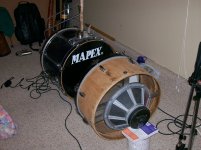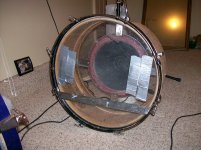Hello all. I found this forum by google search and hope someone here can help me. I'm also hoping I picked the right sub-forum; someone please let me know if another forum would be better for my question.
If my pictures uploaded successfully, you can see the subwoofer microphone I built. Actually, it is more than a mic--it is a sympathetic resonator that goes along with a 10 foot long didgeridoo that I made. The subwoofer is wired in reverse--via XLR--to go to microphone input. Both the drum and didgeridoo are tuned to 45 hz. I record with the sub-mic for my bass track, together with a Shure Beta and Rode NT1A for all the other frequencies, and the result is phenomenal. The sub-mic adds a rich, but clean bass.
(The Mapex drum in the picture is not part of the sub-mic set up. But I am using the sub-mic when I record beats on the Mapex drum.)
The sub-mic-resonator is great for recording and I've already done some recording with it. Unfortunately, speakers are not optimized for input usage and so if I try to perform live with this set up, there is a lot of feedback--long before I'm able to crank up the output speakers to where I want them 🙂
To be able to perform live with this set up, I've been dreaming that maybe it's just a matter of going to Radio Shack and buying the right part. Just wire it in somewhere in the line and rein in the feedback. Isn't there some way I can optimize the speaker not to be so sensitive? (It is extremely sensitive--I have to turn the input knob way down and keep a few feet of distance between the instrument and the mic.)
Thanks, and I'm looking forward to reading your brilliant responses. If anyone's curious about the sound of this, I could try to email you an mp3.
If my pictures uploaded successfully, you can see the subwoofer microphone I built. Actually, it is more than a mic--it is a sympathetic resonator that goes along with a 10 foot long didgeridoo that I made. The subwoofer is wired in reverse--via XLR--to go to microphone input. Both the drum and didgeridoo are tuned to 45 hz. I record with the sub-mic for my bass track, together with a Shure Beta and Rode NT1A for all the other frequencies, and the result is phenomenal. The sub-mic adds a rich, but clean bass.
(The Mapex drum in the picture is not part of the sub-mic set up. But I am using the sub-mic when I record beats on the Mapex drum.)
The sub-mic-resonator is great for recording and I've already done some recording with it. Unfortunately, speakers are not optimized for input usage and so if I try to perform live with this set up, there is a lot of feedback--long before I'm able to crank up the output speakers to where I want them 🙂
To be able to perform live with this set up, I've been dreaming that maybe it's just a matter of going to Radio Shack and buying the right part. Just wire it in somewhere in the line and rein in the feedback. Isn't there some way I can optimize the speaker not to be so sensitive? (It is extremely sensitive--I have to turn the input knob way down and keep a few feet of distance between the instrument and the mic.)
Thanks, and I'm looking forward to reading your brilliant responses. If anyone's curious about the sound of this, I could try to email you an mp3.
Attachments
I'll move this to the MI forum. In the meantime, you might try running the driver into the line input, which will be much less sensitive than a mike input.
The line in suggestion is spot on. Far as Radio Shack parts, yeah, you could make an L pad for the speaker mic to drop the input level. With a big tuned system for a mic I'm not surpised you get feedback problems, although to get rid of it you might try an adjustable phase shift circuit to get rid of the near 180 degree situation between input and output wherever you may be playing. You could also try simply inverting the wiring phase. It might help to note at what frequency you usually get feedback to help you kill it. You could try a notch filter if it's up higher in the band. Just running the mic signal through an EQ can help you pull down centers that like to take off.
I just looked at the pics after loggin in. That's a crazy setup.
There are a handful of people running speakers for drum mics, although I don't think they try to have it resonate much. It's a decent idea because it will be pretty much impossible to overload.
I just looked at the pics after loggin in. That's a crazy setup.
There are a handful of people running speakers for drum mics, although I don't think they try to have it resonate much. It's a decent idea because it will be pretty much impossible to overload.
Last edited:
Thanks for the input.
The L pad idea... I would be using it in reverse, right? In line between the sub-mic and mic input? Or do I have this wrong?
As to the adjustable phase shift circuit... I'm trying really hard to understand this because from my small understanding of phase, this idea seems like the right direction. I understand that 180 degrees refers to waves that are in anti-phase. When you say there is a near 180 degree situation between input and output, is this because of the short time delay between the sound going into the mic, getting processed and then coming out the speakers? If they are in antiphase, though, then doesn't that result in cancellation? Wouldn't that be good for eliminating feedback? Where would the adjustable phase shift circuit be placed?
Thanks for taking the time to educate me
"It might help to note at what frequency you usually get feedback to help you kill it."
The feedback occurs at various frequencies, including the desired frequency of 45 hz. I apply equalizer to remove everything above 60 hz. But then the feedback occurs at the frequency that I don't want to equalize out. Another thing is that the drum head gets caught in the feedback loop and vibrates sympathetically, further reinforcing it. It's kind of an interesting musical instrument all on its own--you can hit the drum head in different spots or stretch it tighter to change the frequency of the feedback loop.
As a separate project, I'd like to incorporate the "talking drum" concept into it, ie, make it possible to quickly change the drum head tension to elicit different notes. It would make a killer bass track.
The L pad idea... I would be using it in reverse, right? In line between the sub-mic and mic input? Or do I have this wrong?
As to the adjustable phase shift circuit... I'm trying really hard to understand this because from my small understanding of phase, this idea seems like the right direction. I understand that 180 degrees refers to waves that are in anti-phase. When you say there is a near 180 degree situation between input and output, is this because of the short time delay between the sound going into the mic, getting processed and then coming out the speakers? If they are in antiphase, though, then doesn't that result in cancellation? Wouldn't that be good for eliminating feedback? Where would the adjustable phase shift circuit be placed?
Thanks for taking the time to educate me
"It might help to note at what frequency you usually get feedback to help you kill it."
The feedback occurs at various frequencies, including the desired frequency of 45 hz. I apply equalizer to remove everything above 60 hz. But then the feedback occurs at the frequency that I don't want to equalize out. Another thing is that the drum head gets caught in the feedback loop and vibrates sympathetically, further reinforcing it. It's kind of an interesting musical instrument all on its own--you can hit the drum head in different spots or stretch it tighter to change the frequency of the feedback loop.
As a separate project, I'd like to incorporate the "talking drum" concept into it, ie, make it possible to quickly change the drum head tension to elicit different notes. It would make a killer bass track.
You can Build a Mic pad with a Few resistors that will attanuate the signal comeing out of the speaker .......
There are several versions available on the market, but the one I have used is the yamaha subkick. The driver they use is very stiff and very damped. The output is close to mic level but I don't know if they use a matching network or output transformer. Judging by the amount of low frequency on it's output I don't think it can be a transformer. Balancing the output or going straight into a good di box is a must though.
- Status
- Not open for further replies.
- Home
- Live Sound
- Instruments and Amps
- Subwoofer as Microphone - A Question

